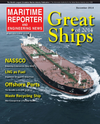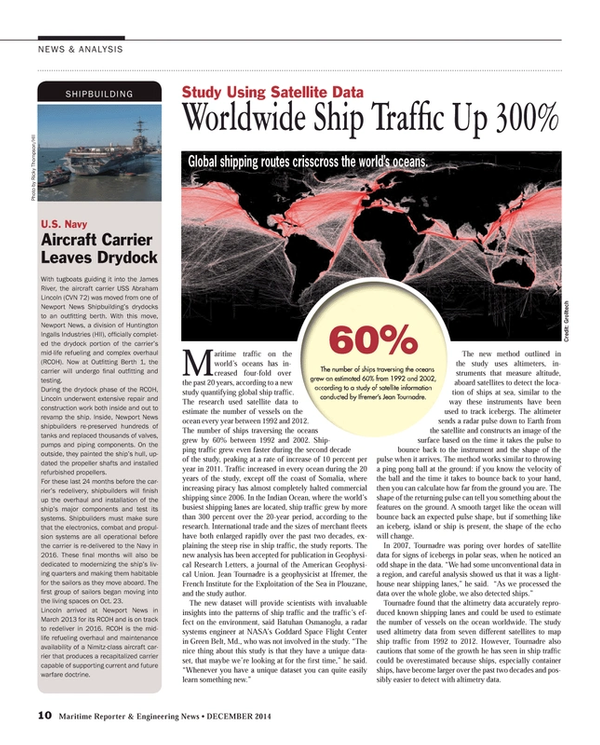
Satellites Reveal Worldwide Ship Traffic Up 300%
Maritime traffic on the world’s oceans has increased four-fold over the past 20 years, according to a new study quantifying global ship traffic. The research used satellite data to estimate the number of vessels on the ocean every year between 1992 and 2012. The number of ships traversing the oceans grew by 60% between 1992 and 2002. Shipping traffic grew even faster during the second decade of the study, peaking at a rate of increase of 10 percent per year in 2011. Traffic increased in every ocean during the 20 years of the study, except off the coast of Somalia, where increasing piracy has almost completely halted commercial shipping since 2006. In the Indian Ocean, where the world’s busiest shipping lanes are located, ship traffic grew by more than 300 percent over the 20-year period, according to the research. International trade and the sizes of merchant fleets have both enlarged rapidly over the past two decades, explaining the steep rise in ship traffic, the study reports. The new analysis has been accepted for publication in Geophysical Research Letters, a journal of the American Geophysical Union. Jean Tournadre is a geophysicist at Ifremer, the French Institute for the Exploitation of the Sea in Plouzane, and the study author.
The new dataset will provide scientists with invaluable insights into the patterns of ship traffic and the traffic’s effect on the environment, said Batuhan Osmanoglu, a radar systems engineer at NASA’s Goddard Space Flight Center in Green Belt, Md., who was not involved in the study. “The nice thing about this study is that they have a unique dataset, that maybe we’re looking at for the first time,” he said. “Whenever you have a unique dataset you can quite easily learn something new.”
The new method outlined in the study uses altimeters, instruments that measure altitude, aboard satellites to detect the location of ships at sea, similar to the way these instruments have been used to track icebergs. The altimeter sends a radar pulse down to Earth from the satellite and constructs an image of the surface based on the time it takes the pulse to bounce back to the instrument and the shape of the pulse when it arrives. The method works similar to throwing a ping pong ball at the ground: if you know the velocity of the ball and the time it takes to bounce back to your hand, then you can calculate how far from the ground you are. The shape of the returning pulse can tell you something about the features on the ground. A smooth target like the ocean will bounce back an expected pulse shape, but if something like an iceberg, island or ship is present, the shape of the echo will change.
In 2007, Tournadre was poring over hordes of satellite data for signs of icebergs in polar seas, when he noticed an odd shape in the data. “We had some unconventional data in a region, and careful analysis showed us that it was a lighthouse near shipping lanes,” he said. “As we processed the data over the whole globe, we also detected ships.”
Tournadre found that the altimetry data accurately reproduced known shipping lanes and could be used to estimate the number of vessels on the ocean worldwide. The study used altimetry data from seven different satellites to map ship traffic from 1992 to 2012. However, Tournadre also cautions that some of the growth he has seen in ship traffic could be overestimated because ships, especially container ships, have become larger over the past two decades and possibly easier to detect with altimetry data.
(As published in the December 2014 edition of Maritime Reporter & Engineering News - http://magazines.marinelink.com/Magazines/MaritimeReporter)
Read Satellites Reveal Worldwide Ship Traffic Up 300% in Pdf, Flash or Html5 edition of December 2014 Maritime Reporter
Other stories from December 2014 issue
Content
- Satellites Reveal Worldwide Ship Traffic Up 300% page: 10
- Bulk Carrier Freight Rates Predicted to Peak in 2016 page: 12
- MLC2006 Impact: 113 Ships Detained page: 13
- Maritime Quarantine & Isolation page: 16
- FPSOs Require Special Monitoring to Support IMR page: 18
- As Interest in LNG Surges, Regulators Struggle to Keep Pace page: 20
- NASSCO: The Face of US Shipbuilding page: 24
- Hempel: Born in Maritime page: 29
- Since 1927, The Damen Way page: 30
- Air Products: Pioneering Gas Processing Solutions page: 32
- Alfa Laval: Keeping it Clean page: 33
- R.W. Fernstrum: Keeping it Cool page: 34
- MAN Diesel & Turbo: Power Play page: 35
- MLS: eLearning Re-thought page: 36
- Great Ships of 2014: Al Kout Environmental, Piracy Protected, Proven page: 40
- Great Ships of 2014: Allseas’ Pieter Schelte page: 42
- Great Ships of 2014: CSCL Globe - world’s largest containership page: 44
- Great Ships of 2014: Harvey Energy page: 45
- Great Ships of 2014: Quantum of the Seas page: 46
- Great Ships of 2014: The Hybrid-Powered Semper Fi page: 47
- Great Ships of 2014: Ceona Amazon page: 48
- Great Ships of 2014: R/V Neil Armstrong - Multifaceted Sea Explorer page: 50
- Great Ships of 2014: Linda Oldendorff page: 51
- Great Ships of 2014: CSAV Tyndall page: 52
- Great Ships of 2014: Top Coral Do Atlantico - A 'Mega' Pipelayer page: 52
- Great Ships of 2014: Linda Oldendorff page: 53
- Great Ships of 2014: Harvest Frost page: 53
- Great Ships of 2014: Gas Star - 84,000 CBM LPG Carrier page: 54
- Great Ships of 2014: M/V Harvest Leader - ECO Class PCTC page: 55
- Lindenau’s Concept: Waste Recycling Ships page: 56
- Great ships of 2014: Siem Moxie page: 57
- Great Ships of 2014: Höegh Jacksonville page: 57
- Are Offshore Ports the Future? page: 58
- Marine Lubricants: New Year, New Emission Rules page: 62
- Phoenix EcoMod 450 Floodlight page: 71
- MES, Viking Yachts Partner for Quiet Performance page: 71
- Air Purifying System for Tug-turned-superyacht page: 71
- Norsafe for Pieter Schelte page: 71
- EnviroLogic: SVGP Compliant Fluids & Cleaners page: 71
- ExxonMobil Debuts Zinc-free Marine Engine Oil page: 71
- Water Reclamation System Delivered to Transocean page: 71
- Ocean Signal Debuts RescueME EPIRB1 page: 71
- NEW EAL from Shell: Naturelle Stern Tube Fluid page: 71
- Inventor. Builder. Entrepreneur. Optimist. Schweitzer page: 86


